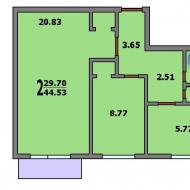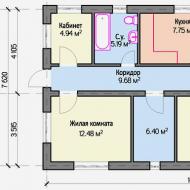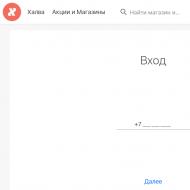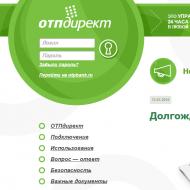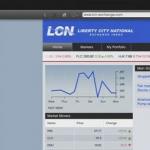
Fill the balance of UCN revenues. Simplified accounting balance: Example of filling
The balance sheet is the species of reporting that the legislatures have obliged to pass almost all enterprises. This document It serves to display all the processes that occur within the firm. An example of compilation accounting balance For "kettles" we call the theoretical consideration of this process than and we will deal with this article.
Simplified balance form available by software.
A little theory of accounting balance. The structure of the report is determined by two tables, one of which is called the asset, and the second is a passive.
Assets

The asset includes all ownership of an enterprise that can be translated into cash equivalent. It can be a room, and equipment, and vehicles, which is in the company's own. The asses also include those amounts that other enterprises can be given. All elements of the asset should be displayed in cash.
Similar words, this is all that belongs to this enterprise.
The asset has its own structure. It fragmena is non-current assets. These are the property of the enterprise to which it enjoys a long time in order to successfully implement their entrepreneurial activities. This category includes buildings, equipment, vehicles, etc.
The second fragment of the asset structure is a revolving asset. The final indicator is the amount of funds that are used by this enterprise relatively long and require constant replenishment. This category includes materials, goods, raw materials, receivables, which will be returned soon, etc.
Passive

Passive is provided in order to display those sources from which funds placed in the asset appear. It also has its classification and may consist of such groups:
- attracted funds (loans and loans);
- own capital of the company;
- authorized capital;
- external obligations (debts to suppliers, taxes, etc.)
Passive has three main structural sections:
- All means belonging to the company's founders or to it organize Count "Capital and Reserve Means".
- The entire amount of debt, to pay which in the near future there is no need to be paid in a period exceeding the year form a section "long-term liabilities".
- Wages, debts to suppliers for the goods, as well as to be paid in the near future, form a section "short-term liabilities".
Achieving equality between is the main goal of the accounting balance. It is compiled in form 1 for the balance sheet adopted by law to approval in 2010. This reporting form is issued rather as a recommendation document and can undergo changes associated with the peculiarities of the organization's activities.
Balance and instruction filling
The formation of an accounting balance is carried out in the process of filling in the entrepreneur of all lines designed for this form, taking into account the subtleties and nuances carried out by the firm.
Both half of the document are formed by rows, which are individually made by those indicators that characterize the financial position of this enterprise.
Each line has its own sequence number, and also shows the name of the indicator that is displayed in this line.
The total amount of the asset, taking into account the procedure for filling the balance sheet, is by summing up all the indicators in according to their sequence over the first two balance sections.
An example of filling asset in the balance sheet:

An example of filling the balance liability:

Sometimes some lines can be made to zero, then this fact should be explained in the accompanying balance of documents.
The reflection of the amounts in the balance sheet occurs, taking into account the reduction of sums by three or six zeros (in thousands or millions). So, if the cost of real estate, which is in the possession of this company is 10,000,000 rubles, then in the balance sheet this amount can be reflected as 10,000 thousand. Some companies whose scale is very large, can use their own reduction, convenient for them.
Choose, to express the indicators, you can when filling in the shape of the balance form:

Complete instructions, how to make a balance for dummies, you can see in this video:
So, responding to how to make an accounting balance, two of its main components should be considered - this is an asset and liabilities that are represented by two tables and are intended to display all financial processes, occurring within the company and in its interaction with other organizations, from the point of view of the financial operation itself, as well as its source.
Most recently, the legislator allowed us to take a simplified accounting balance. The Ministry of Finance has developed lightweight forms and in 2013 firms could use them when reporting in 2012 was given.
The balance sheet for simplified form for 2016 may not pass all the companies, but only those relating to small business entities. It is very convenient, as the balance for small enterprises for 2016 may contain a much smaller number of forms compared to the traditional full form. accounting reporting. A small company itself can decide that it is more convenient - a full-fledged report or its simplified version. The selected method must be reflected in the current accounting policy.
Who gives simplified accounting balance
For a facilitated form, the balance of a small enterprise for 2016 can give up. Also using this right can companies participate in the implementation of the Skolkovo innovation project, non-profit enterprises.
For small enterprises include legal entities:
- with the average number of employees no more than 100 people. Recall that the average number differs from the list of numbers. The procedure for calculation is fixed in legislative Act state statistics (order from 10/28/13 No. 428);
- who have income from their commercial activities does not exceed 800 million rubles.
- for other grounds contained in paragraph 1.1. Article 4 of Law No. 209-FZ.
The balance sheet for simplified form cannot surrender by companies that provide for a mandatory reporting audit (any joint-stock company falls here, as for them audit report It is necessary), construction and housing cooperatives, microfinance enterprises, government agencies, notarial offices, lawyers, parties and a number of others.
How to make a balance of small enterprise
The balance sheet of a small enterprise is formed in accordance with the annex to order No. 66N, approved by the Ministry of Finance July 02, 2010 In addition to the indicators for the reporting year, it indicates indicators for the two previous years, for this, special columns are provided, where data is entered at the end of the year.
OKD form 0710001 (Balance for small enterprises now is now this number) is used for reporting for the current 2016, as well as for 2015. Prior to that, another form was used, which was used from 2012 to 2014.
The balance for small enterprises 2016 includes two forms - the accounting balance itself (form 1) and the financial results report (form 2). If the company finds it necessary to provide more forms to disclose the missing information, it is allowed.
Companies using the form of OKD 0710001 indicate data largely without detail by articles, since this form reflects more general indicators and the number of rows in the form is significantly less.
It doesn't matter what taxation system has chosen the company, possibly USN, without exception, it is necessary to report to government agencies and amounted to annual accounting reporting.
Regardless which statement of the reporting provided is complete or simplified, the legislative periods of its submission are required. For 2016, it is surrendered until March 31, 2017 (Thursday). When skipping a legitimate period is followed by significant fines. Since we submit reporting in obligatory into two government agencies - this is the tax inspectorate and statistical bodies, both are different fines. In the first case, it will have to be paid 200 rubles for each not submitted document in time, in the second case it provides for responsibility from 3,000 to 5,000 rubles.
When the activity is not conducted, the firms should still be given the zero reporting, otherwise the fines are waiting for the same.
How to fill out a simplified accounting balance of 2016?
For each of the lines of balance, indicators are given for 3 years, if there is no indicator, then the battle is made. The code in the string is affixed depending on whether the proportion of this enlarged indicator is the largest.
Simplified accounting balance: Example of filling
For example, if the company at the end of the reporting period is most of receivables, then in the line "Financial and other circulating assets" in the balance sheet code 1230 (see an example of the balance of the balance for a small enterprise below).
Simplified balance for small businesses: Instructions for filling
Let's start by S. Asset Balance. It consists of five sections and balance currency in the asset section (string 1600). The asset reflects all the company's property that is divided into negotiable and fixed assets.
In the "Material Outcast Assets" line, data on fixed assets are reflected. It can be buildings, structures, transport, etc. The balance of accounts 01 and 03 minus the balance of 02 accounts are entered here, and the costs of incomplete construction (account 08) are added.
In the string "Intangible, financial and other non-current assets" is formed the cost of intangible assets (they include: scientific works, works of art, computer programs, inventions, etc.), reflects the balances on deposits (score 55), long-term investments ( Account 58), as well as balance on debt on accounts 60, 62, 68, 69, 70, 71, 73, 75, and 76.
Filling the line "stocks" of the simplified balance sheet does not differ from the generally accepted filling of accounting reporting. In stocks, the cost of raw materials and materials not transmitted to production, but taken into account on the debit of accounts 10, 15, 16, the cost of finished products reflected in the debit of accounts 43 and 45, the amount of costs for incomplete production, accountable on accounts 20,23,29 etc.
The line "Cash and cash equivalents" indicates the availability of cash companies in russian rubles and foreign currencywhich are available on accounts or at the enterprise's cash desk, as well as cash equivalents. Reflects the balance of accounts: 50, 51, 52, 55 (except for the amounts reflected in lines 1170 and 1240), 57.
The line "Financial and other current assets" displays information about short-term financial investments (account 58), account receivables, presented by VAT, but not adopted by deduction, the amount of excise taxes and other current assets of the organization.
In the currency of the Asset - this is the line 1600, the sum of all the indicators discussed above is indicated. It reflects all the property of the company.
Passive simplified balance It consists of 6 sections and reflects the sources of formation of the company's funds. Sources are in the form own fundsThey are reflected in the Row "Capital and Reserves" and include information on statutory and additional capital, the reserve fund and retained earnings. This includes data on accounts 80 (minus the debit balance of account 81), 82, 83 and 84.
Also companies attract borrowed cashwhich are fixed in the string "Long-term borrowed funds" There are debt on long-term loans and borrowings (account 67). Under long-term is the obligations with maturity more than 1 year. This line reflects the balance of accounts 60, 62, 68, 69, 70, 71, 73, 75 and 76. And there are still "short-term borrowed funds", it reflects the balance of 66.
The name of the line "Accounts debt" fully reveals its essence. Here are the indicators of credit balance accounts 60, 62, 68, 69, 70, 71, 73, 75 and 76.
Row "Others short-term liabilities»It may not be filled, if all information is already indicated.
Row indicator 1700 reflects the overall magnitude of the liabilities of the organization. The results of the asset and liability must be equal.
An example of filling the simplified balance sheet

Simplified financial results report: Filling Sample


Download Simplified Balance Blanc
According to the materials of the site, a modern entrepreneur (C)
Home - Documents
Balance of simplified form
No later than April 1, 2013, the accounting statements for 2012 should be submitted to the IFTS, which is compulsia of the balance sheet. Subjects of small entrepreneurship in its formation are entitled to take advantage of the simplified form developed by representatives of the Ministry of Finance.
The balance sheet characterizes the financial position of the organization as of the reporting date (paragraph 18 of PBU 4/99).
It provides indicators (Appendix 5 to order N 66N):
- at the reporting date (as of December 31, 2012);
- december 31 of the previous year (as of December 31, 2011);
- as of December 31, the previous year preceding the previous one (as of December 31, 2010).
We remind you that in accordance with paragraph 19 of PBU 4/99 in the balance sheet assets and obligations reflected with a division into short-term and long-term. At the same time, assets and liabilities are represented as short-term, if the appeal (repayment) for them is not more than 12 months after the reporting date or the duration of the operational cycle, if it exceeds 12 months.
All other assets and liabilities are long-term.
Assets
The balance of the balance for small business entities consists of only five lines:
- material non-current assets;
- intangible, financial and other non-current assets;
- stocks;
- cash and their equivalents;
- financial and other revolving assets.
note! Small enterprises have the right to not count such indicators as deferred tax assets, deferred tax liabilities, etc. Objects. This is indicated in paragraph 2 of PBU 18/02 "Accounting for calculations on the income tax of organizations" (approved by the Order of the Ministry of Finance of Russia dated November 19, 2002 N 114n).
Row " Material non-current assets"reflect both the cost of fixed assets and unfinished capital investments in fixed assets. At the same time, the balance sheet should include numeric indicators in net-valuation, i.e. minus regulators (p. 35 PBU 4/99). The value of the initial (current, reducing) value of fixed assets is the amount of accrued depreciation. A similar rule is applied when taking into account intangible assets.
In line " Intangible, financial and other non-current assets"Show:
- intangible assets;
- incomplete investments in intangible assets;
- research results and development;
- long-term financial investments;
- deferred tax assets;
- expenditures of future periods, etc.
As a rule, organizations have to share financial investments on those on which one can determine the current market value, and those for which their current market value is not determined.
Meanwhile, small enterprises all financial investments have the right to take into account at their initial cost. This conclusion follows from paragraph 19 of PBU 19/02 (approved by the Order of the Ministry of Finance of Russia dated December 10, 2002 N 126n). If any costs meet the conditions for the recognition of a certain asset established by the regulatory legal acts According to accounting (PBU 6/01, PBU 5/01, PBU 14/2007, etc.), they should be shown in the balance sheet in this asset (the letter of the Ministry of Finance of Russia dated November 17, 2011 N 07-02-06 / 220).
How to fill out a general and simplified accounting balance, instructions with decoding strings
In other cases, such costs reflect as expenses of future periods. Then they are subject to debiting through their distribution between the reporting periods in the manner prescribed by the organization during the period to which they relate (the letter of the Ministry of Finance of Russia of January 12, 2012 N 07-02-06 / 5). Expenditures of future periods appear in PBU 14/2007 "Accounting for intangible assets" and PBU 2/2008 "Contract Accounting construction contract"(approved by the orders of the Ministry of Finance of Russia dated December 27, 2007 N 153N and on October 24, 2008 N 116n, respectively).
In the string " Stocks"Not only information about raw materials and materials should be included, but also about finished products, about the product, etc. This conclusion follows from paragraph 20 of PBU 4/99 and paragraph 2 of PBU 5/01" Accounting of material and production reserves " (approved by the order of the Ministry of Finance of Russia dated June 9, 2001 N 44N).
Row " Cash and cash equivalents"Show balances on cash and cash equivalents. Speech here is about highly liquid financial investments that can be easily addressed in a predetermined amount of funds and which are subject to minor risk of value change. Such a definition is set out in paragraph 5 of PBU 23/2011" Report On the movement of funds "(approved by the order of the Ministry of Finance of Russia of February 2, 2011 N 11N). Example of money equivalent serves open in credit organizations Deposits "to demand".
Line " Financial and other revolving assets" intended for:
- short-term financial investments;
- receivables;
- value added tax;
- other revolving assets that have not included in other lines of balance.
On the line "Financial investments (with the exception of cash equivalents)" section "Redeems" should show information on financial investments, the appeal (repayment) for which is not more than 12 months after the reporting date or the duration of the operational cycle, if it exceeds 12 months. This follows from paragraph 41 of PBU 19/02 and p. 19 PBU 4/99. VAT shows the balance of the account 19 (it is possible when implementing export operations, with a long production cycle, etc.).
Passive
Balance liabilities form the following indicators:
- capital and reserves;
- long-term borrowed funds;
- others long term duties;
- short-term borrowed funds;
- accounts payable;
- other short-term liabilities.
Row " Capital and reserves"Show authorized capital, additional capital, reserve capitalretained earnings (uncovered loss), etc. The specified enlargement is very logical, because Small enterprises have the right to account for capital to use account 80 "authorized capital" instead of accounts 80, 82 and 83 (PP. "B" of paragraph 3.2 of information of the Ministry of Finance of Russia N PZ-3/2012).
It should be borne in mind that the balance sheet reflects the value of the statutory (share) capital, registered in the constituent documents (clause 67 of the order N 34N). This indicator does not depend on the debt of the founders on deposits.
As part additional capital reflect the difference arising from the recalculation of the cost of the assets and obligations of the Organization used to conduct activities outside Russian Federation. This is indicated in paragraph 19 of PBU 3/2006 "Accounting for assets and liabilities whose cost is expressed in foreign currency" (approved by the Order of the Ministry of Finance of Russia dated November 27, 2006 N 154N).
When calculating the indicator "Retained earnings (loss)" summarizes the balance of 99 "profit and losses" with a balance on account 84 "retained earnings (uncovered loss)." Debit is a loss, credit - profit. In this case, the loss reflect as a subtracted indicator in parentheses. Recall that the decision on the distribution of net profit either about the repayment of the loss is competence general Assembly Participants in the Company (PP. 11, paragraph 1 of Art. 48 of the Law of December 26, 1995 N 208-FZ and PP. 7, paragraph 2 of Art. 33 of the Law of February 8, 1998 N 14-FZ).
In line " Long-term borrowed funds"Reflect the debt on loans and loans, the repayment period for which at the reporting date exceeds 12 months. In accordance with paragraph 73 of the Order No. 34n, this debt reflects in accordance with interest due to payment, at the end of the reporting period.
In turn, for short-term loans and loans is a string " Short-term borrowed funds". If the maturity of the borrowed funds previously submitted in the balance sheet as long-term obligations, the reporting date is less than 12 months, the indicated obligations are represented as short-term. This conclusion was sounded in the letter of the Ministry of Finance of Russia dated January 28, 2010 N 07-02- 18/01.
It is important! Small enterprises (with the exception of issuers publicly placed valuable papers) It is entitled to not reflect the appraisal obligations, conditional obligations and conditional assets in accounting (clause 3 of PBU 8/2010).
Row " Other long-term commitments"reflect deferred tax liabilities (if an enterprise is recorded in accordance with PBU 18/02), long-term assessment obligations, etc.
At the same time, it is necessary to take into account that conditional obligations and conditional assets are not recognized in accounting, but information on them should be shown in the accounting reporting. This is indicated in paragraph 14 of PBU 8/2010 "Estimated obligations, conditional obligations and conditional assets" (approved by the Order of the Ministry of Finance of Russia dated December 13, 2010 N 167n). An assessment commitment takes into account 96 "reserves upcoming expenses"(p. 8 PBU 8/2010). The most reliable estimation of expenses is the value necessary directly for the fulfillment of the obligation as of the reporting date or to transfer the obligation to another person (the letters of the Ministry of Finance of Russia of August 17, 2012 N 07-02 -06/205 and dated January 27, 2012 N 07-02-18 / 01). For example, the assessment commitments are the obligations of the organization in connection with the emergence of the employees of the rights to paid leave (the letter of the Ministry of Finance of Russia of April 19, 2012 n 07-02-06 / 110).
In turn, the value of the assessment obligation in the case of the execution of obviously unprofitable contracts is determined as the smallest of two values \u200b\u200b- exceeding the inevitable expenses for the implementation of such a contract and the expected income on it or as an amount of sanctions for termination of the contract. This conclusion was sounded in the letter of the Ministry of Finance of Russia of January 27, 2012 N 07-02-18 / 01.
Row " Accounts payable"Show short-term debt to suppliers, employees, budget, etc.
In line " Other short-term commitments"Take into account other short-term liabilities that do not fall into other lines of balance.
February 2013

Not all companies need to keep accounting. However, the reporting is necessary to each enterprise, however, for small business, its simplified form has been created. For example, only 11 lines remain in the balance sheet: 5 by asset and 6 by passive. In addition to it, fill out a report on financial results and pass these 2 documents in tax service And Rosstat until March 31.
Report to the state according to the results of activity - the duty of any enterprise (FZ of 06.12.2011 N 402-FZ). And it should be done in a timely manner. Nestyage reporting entails fines and increases the likelihood of tax audit.
Small business reporting
Accounting requirements are shown in the Federal Law No. 5.12.2011 N 402-FZ. The basis of accounting is a balance and a report on financial results. It is also necessary to draw up an explanatory note if there is a need for this.
The accounting statements of small enterprises can be complete or simplified.
Simplified form can apply:
- small business;
- non-commercial organizations.
This can be done only if the scope of activity is not in the list of exceptions. In particular, the company refers to microfinance companies, legal advice, notarized and law bureau.
Criteria for small enterprises
A small business entities include companies if:
- their revenue without VAT over the past calendar year amounted to 800 million rubles;
- the average number of employees did not exceed 100 people;
- the share of the state, funds, large companies up to 25%.

Fig. 1. Small business
At the same time, it does not matter what taxation system is applied, because From this status, the requirements for financial statements and accounting are dependent. Tax account is another.
However, in 2015, all enterprises on simplified are automatically equated to small business entities. Everything is simple: to apply the USN, the revenue should not be higher than 64 million rubles. per year and this value is included in the limit of 800 million rubles. But again, if the company is suitable for the share of state / funds. The composition of the founders in this issue is important.
The status of a small enterprise is assigned to the company, if for three years in a row it satisfies the criteria listed above. For example, 2013, 2014 and 2015. So that the company belonged to a small business entity, no documents need to submit any documents.
If the company only registered, then in the first year, with the observance of the limit on operations, the number of employees and the appropriate composition of the founders, the company automatically relates to small businesses.
Accounting documents
Small companies can form reporting on a simplified scheme. But they also have the right to do it on the general basis. At each enterprise, this issue solve themselves. In addition, the form can be developed independently.
And in that, and in another case, 2 documents are minted (download reporting form 2015):
- balance;
- report on financial results (earlier - report on profit and loss).
The difference between them lies in the need for detail. In the simplified version, it is not necessary to paint everything according to the articles, in general, it is necessary. In the first case, a simpler form, in the second it is more difficult.
Before completing the documents, it is necessary to make final wiring per year, close all the accounts of the company.

Fig. 2. Balance form for small businesses
For comparison: the full form of the partition of the liability "V. Short-term obligations "OAO Gazprom for 2014.

Fig. 3. Example of one partition full form
In a simplified form, as opposed to the full one line.

Simplified accounting statements: who gives
4. Form of the report on financial results
If you need to specify additional information, without which it is impossible to estimate the financial condition of the organization, or it is necessary to disclose the principles accounting Policy And other important information make up the application.
How to fill out forms
The basis for filling out forms - data accounting. Before filling, you need to do all wiring and close open accounts (download completed example).
Changes can not be made. If simplified form is not possible to register need informationYou should use a shared blank.
You can correct errors. How to do it, tells in the video:
When enlarging the indicators, the code code must be specified from the group whose share is greater.
To report
If the company is registered after September 30, it should be reported not next year, but in a year and for the entire period from the beginning of the activities.
It is necessary to report in the year, the intermediate forms are not required. But this is possible for self-test or at the request of the company's management.
Submit reporting is necessary in 2 organs:
- tax inspection;
- Rosstat.
Note: for Small enterprises Accounting can be conducted independently (saving on an accountant) with the help of the Internet service "My Business".
Peter Stolypin, 2015-09-05
Questions and answers on the topic
On the material is not yet asked any question, you have the opportunity to do it first.
Simplified accounting (financial) reporting
Economic entities specified in Part 4 of Art. 6. Federal Law From 06.12.2011 N 402-FZ "On Accounting", may form accounting reports on a simplified system or in the general order (paragraph 6 of the order of the Ministry of Finance of Russia from 02.07.2010 N 66n). The corresponding decision is made by organizations on their own.
An organization that applies simplified accounting methods, including simplified accounting (financial) reporting, may:
- draw up accounting reporting in abbreviated volume (balance sheet and financial results report - for commercial organization; Accounting balance and report on target use funds - for a non-profit organization). In particular, the solution to the inclusion in the accounting statements of the report on capital changes and the cash flow report is determined by the need to bring in applications to the accounting balance sheet, the report on financial results, the report on the targeted funds of the most important information, without knowledge of which is impossible to assess the financial situation. Organizations or financial results of its activities (PP. "B" of paragraph 6 of the order of the Ministry of Finance of Russia of 02.07.2010 N 66n, paragraph 26 of the information of the Ministry of Finance of Russia dated June 29, 2016 N PZ-3/2016);
- Use simplified forms of balance sheet, report on financial results and a report on the targeted use of funds (clause 6.1 of the Order of the Ministry of Finance of Russia from 02.07.2010 N 66n, paragraph 27 of the Ministry of Finance of Russia from 29.06.2016 N PZ-3/2016).
Accounting Balance for Small Enterprises (Features)
If the organization does not apply the specified forms, then to the balance sheet, a report on financial results, a report on the targeted use of funds, it may include indicators only by groups of articles (without detailing indicators for articles) (PP. "A" Clause 6 of the Order of the Ministry of Finance of Russia 07/02/2010 N 66N, clause 27.1 of the information of the Ministry of Finance of Russia dated June 29, 2016 N PZ-3/2016).
ATTENTION! Religious organizations that for reporting (tax) periods of the calendar year did not arise obligations to pay taxes and fees, are not required to submit tax authority annual accounting (financial) reporting
Simplified accounting (financial) reporting (CBD 0710096) \u003e\u003e\u003e
Simplified form of accounting balance (OKD 0710001) \u003e\u003e\u003e
Simplified Form of Financial Results Report (OKD 0710002) \u003e\u003e\u003e
Simplified form of a report on targeted use of funds (OKD 0710006) \u003e\u003e\u003e
The value of the line 2120 "Sales cost" (for 2015) Accountant determined on the basis of the data on the total for 2015 debit turn on the subaccount "Cost of sales" of the account 90 "Sales" in correspondence with the score of 20 "Basic Production". The cost of services rendered for 2015 amounted to 634,943 rubles. An indicator of the line 2120 of the previous year, an accountant suffered from a report on financial results for 2014: - 205,000 rubles. The organization did not attract borrowed funds. Income in the form of interest received, respectively, no. Therefore, the line 2330 "interest to payment" of the report on financial results is not filled. Other income and other expenses are absent. Therefore, the lines 2340 "Other incomes" and 2340 "Other expenses" of the report on financial results are not filled.
Accounting reporting of small enterprises
At the same time, the final record of December, the amount of net profit of the reporting year has written off from account 99 "Profit and losses" on credit of account 84 "Retained earnings (uncovered loss)": Debit 99 subaccount "Net profit (loss)" Credit 84-306 057 rub. (326,057 rub. - 20 000 rubles.) - Clealed (unallocated) profit of the reporting year. After reflection of all economic operations Accounting Accountant received the following data on accounting accounts for 2015: Table 3 Volume account for 2015, rub.
Debit Credit 90 "Sales" subaccount "Revenue" 961,000 90 "Sales" subaccount "Cost of sales" in correspondence with account 20 "Basic production" 634 943 99 "Profit and losses" subaccount "Consumption of single tax»20 000 99" Profit and losses "in correspondence with the account 84" Retained earnings (uncovered loss) 306 057 Table 4 Name of the indicator for 2014, thousands
Error 404
Attention
According to the results of the completed strings, the final result is considered to be asses and liabilities, after which these two values \u200b\u200bare compared. Download Sample Balance For Small Enterprises For 2014, you can at the end of the article.
A sample of filling out a report on financial results (about profit and loss) For each report line, you must specify the data for the reporting year and for the same period of the previous year. The report cap is filled in a similar to the profits and loss statement form 2.
The profit and loss account itself contains the following lines: the amount of revenue - income from the main activity, of which VAT and excise tax are deducted (expendable customs duties should not be subtracted). Costs for the main activity - the volume of all costs for entrepreneurship without separation, managerial and commercial costs (in parentheses it is necessary to specify deductions and minus indicators).
Online magazine for accountant
Organization Name Limited Liability Company "Sportmaster" TIN 7728551528 economic activity by classifier OKVED 52.42.1 code in OKPO 77522772 Form of ownership (OKFS) 23 - Foreign property legal entities Organizational and legal form (by OKOPF) 65 - Type of Report 2 - Full Unit of Measurement 384 - Thousand rubles Companion composition
- Balance sheet
- Income statement
- Capital Change Report
- Cash Movement Report
Reporting for other years for the convenience of reporting perception is hidden zero strokes Print Download Dossier on Sportmaster LLC Accounting Balance Name Row Code December 31, 2015 As of December 31, 2014 asset I.
Simplified reporting of small enterprises
The Accounting Policy "Alpha" provides that the revenue is defined as money from buyers is received, expenses are recognized as payment and reduce the financial result. current period (p. 7 PBU 1/2008, p. 12 PBU 9/99, p. 18 and 19 PBU 10/99). The expenses of the organization in 2015 amounted to:
- salary - 150,000 rubles.
(actually paid on hand 100,000 rubles.); - NDFL - 14,943 rubles. (actually listed PMFL in the budget);
- insurance premiums - 119 700 rubles. (50,000 rubles are actually paid);
- rent - 230 300 rubles. (actually listed 70,000 rubles.);
- materials - 150,000 rubles. (actually paid 150,000 rubles.);
- depreciation - 250,000 rubles. (fixed assets are fully paid);
- unified tax for 2014 - 20,000 rubles.
Fill form 2 of the balance sheet (sample)
And for beginnings, we note that not all small businesses can conduct simplified accounting and take simplified accounting reporting. Exceptions are indicated in paragraph 5 of Article 6 of the Federal Law of December 6, 2011 No. 402-FZ.
For example, microfinance organizations and companies will not be able to use this benefit of this benefit, the accounting statements of which are subject to compulsory audit (for example, joint Stock Company) (Art.
Simplified balance form for small enterprises
5 of the Federal Law of December 30, 2008 No. 307-FZ). We also remind what firms are generally small. These are companies that satisfy the criteria listed in Article 4 of the Federal Law of July 24, 2007 No. 209-FZ. Their three:
- the size of the company's revenue - income from the sale of goods, works or services (excluding VAT) may not exceed 400 million

 NewsPermalink.
NewsPermalink.
To pass the accounting report for 2016, you need to use a new form to transfer the company's balance sheet information. This article published how to properly fill in the lines on line, as well as specific example already fully decorated document
09.11.2016Structure of accountability for 2016
Accounting reporting documentation for 2016 is transferred to companies at once in two services by their location:
statistical;
tax.
For the current 2016, the following accountability is rented:
balance sheet;
income statement;
applications to two named reports (this may be depending on the situation reports on capital changes, finance movements, targeted use of funds).
We also provide for the legislation that it is possible to add explanations that are made in the form of texts or tables. But the audit conclusion should be made in obligatory. It contains confirmation of the reliability of all accounting documents. But this is done in the case when the company is subject to audit check - Federal Law, Law No. 402, Article 13, para. 10.
Non-commercial type companies also give accountability, the structure of which is as follows:
target use of money;
applications to mandatory reports.
For IP, such accounting reports will not be needed. For small business entities there is a delivery of accountability in a simplified version. Here is its main nuances:
The balance sheet immediately includes reporting data on financial performance, but without detail.
Applications are only the information that is needed when evaluating the financial position of this company or to assess its financial performance.
In the absence of information for the design of named applications, only mandatory forms are filled - the balance sheet and financial results. These rules are confirmed by the following official documents:
order No. 66N (paragraph 6);
letter No. 03-02-07 / 1-80 of the Ministry of Finance of Our State;
information NP-3/2010 Ministry of Finance (paragraph 17).
What time frame should be the balance sheet for the current 2016?
Accountability for the annual period is surrendered by firms to the local tax service for 3 months from the date of completion of the reporting period, that is, year - tax code, Article number 23 (paragraph 1, subparagraph 5). The statistical service reports this report in the same time - FZ, Law No. 402, Article 18 (paragraph 2).
The reporting document with the company's balance sheet information for 2016 is transferred to the relevant departments of local services by March 31 of the following year (in our case - 2017). Intermediate accountability, which is made in the company for the convenience of accounting, do not need to be transferred to tax and statistical services.
Clean report form (relevant for 2016-2017)
Download clean forms to fill the balance sheet:
Features of a simplified form financial statements For the current 2016
Simplified accounting (financial) reporting includes an accounting balance sheet, a report on financial results and a report on the targeted use of funds. For the 2016 report, the following key dates are used:
In the simplified form of balance fill two mandatory parts:
an asset is non-current and current values;
passive - the values \u200b\u200bof its capital, borrowed finances, payables.
The final results according to these sections are recorded in C1600 and C1700, while their digital values \u200b\u200bmust be equal to each other. The remaining lines also have their own encoding, which is affixed in the additional column (it is added to the report independently). Such an encoding is affixed by the digital indicator, which has the greatest specific weight in the structure of the enlarged indicator - Order No. 66n (paragraph 5).
In the enlarged articles of the Balance Report on USN for 2016 include:
| 1. Material non-current assets (main money + unfinished investment in them). | 1. Capital and reserves (share capital + additional and reserve capital + retained earnings + uncovered loss + revaluation of basic cash (intangible type assets) + its own research papers (which were redeemed for subsequent cancellation) or the share of founders). |
| 2. Intangible, financial non-current assets (intangible assets + long-term cash, with the inclusion of research results, unfinished investments in the assets of intangible type, research). | 2. Long-term borrowed funds (money obtained as a result of loans or long-term loans). |
| 3. Stocks (the same article exists in the general version of the balance sheet). | 3. Cross-type borrowed funds (money obtained by loans or short-term loans). |
| 4. Cash and equivalents (the same article exists in the overall version of the balance sheet). | 4. Credit debt (digital indicator of the summation of the company of a short-term type in advance of creditors). |
| 5. Financial and other assets of a revolving type (short-term investments + receivables + other assets). | 5. Other obligations (short and long-term nature). |
Features of the total forms of the balance sheet for 2016
Features of the total form of the balance sheet report are submitted in the order No. 66n, namely in Appendix No. 1 to it. The subjects of small entrepreneurship can be used by this form, although they have developed a simplified version of this report.
The balance sheet report on this form also contains several graphs in which indicators should be reflected on the following dates (for 2016):
Consider now all the nuances for each column separately.
№1 - The number of explanations is affixed to the balance sheet (if there is an explanatory note),
№3 - Additionally added graph for line of line encoding.
As well as a simplified form, the overall has two main parts:
The asset reflects the size of all assets, both turnover and non-refinery.
Passive - reflects the magnitude of his own capital + borrowed funds + payables.
We describe the balance sheet on the sections:
Section number 1 - non-current assets.
Assets of intangible type. In C1110, they prescribe the residual value of the asset of the intangible type (in accordance with Order No. 153n of the Ministry of Finance of our state, namely, paragraph No. 3 of PBU 14/2007).
The objects of intangible assets include those suitable for the following criteria:
the ability to benefit in economically;
the ability to identify (isolation / separation) from other assets;
destination for use for a long time period (over 12 months);
reliable determination of the initial value of the object (by fact);
there is no material and real form.
Example: If the above conditions coincide, the object belongs to the assets of the intangible type - these are works of science, literature, art, various inventions, secret developments, trademarks, etc. In addition to this, they can be counted and a business reputation that may appear when buying a company as a property complex (although it can only be part of it).
Specialists recommend paying attention to the next nuance: the expenses of the intangible type cannot be attributed to the expenses that are associated with the organization of the company itself (Jurlitz), the quality of personnel of the company - intellectual and business, qualifying abilities and the attitude to work activity - PBU 14/2007, para. 4.
C1120 - the results of research and development, which is recorded in the account "04" (intangible assets).
C1130 - C1140 - Indicators of search assets, both material and intangible (for companies that are subsoil users, they reflect the costs used for development in these lines natural resources - PBU 24/2011, in accordance with Order No. 125n of the Ministry of Finance of our state).
C1150 - Basic Types. This line includes the indicator of the residual value of funds of the main type according to amortized objects, for an unimportible object - an initial value indicator. Those assets that are attributed to the funds of the main type, must comply with PBU 6/01 (clause 4), by order No. 25n of the Ministry of Finance. These objects are compulsory available in the company's property or in the right of operational management or in the management of the economy. The funds of the main type include also the property that the company receives on the basis of a leasing agreement followed by accounting on the balance of the recipient of this leasing. Those objects that fall under mandatory registration with property rights are also related to the funds of the main type (as soon as they are taken into account on the company's balance sheet).
It is worth paying attention to the fact that in this section there is no reflection of expenses for the construction of real estate objects - the string "unfinished construction". These costs are entered into this line C1150 - PBU 4/99 (paragraph 20), in accordance with Order No. 43N of the Ministry of Finance. Although you can add an additional line to decode costs for incomplete construction.
C1160 - information on profitable investments in the matzenity. They, first of all, include the residual value of the property, which is leased (that is, leasing), followed by regard to the account "03". In the event that this property was applied in connection with other production needs, and after that it will be leased, its reflection is made on a separate subaccount of the account "01" - the composition of the main type of funds. But the transfer of the cost of funds of the main type in profitable investments and vice versa is not produced - letter №grv-6-21 / [Email Protected] FTS (from 19.05.05).
C1170 - financial investments of a long-term nature (for a period of more than 12 months), short-term reflected in C1240 - this section No. 2, the line "Current assets". Long-term investments include investments in subsidiaries. Financial investments are taken into account in the amount that was spent for their acquisition. At the same time, the cost of its shares, which were redeemed from the company's shareholders for subsequent resale or cancellation (C1320) + interest-free loans, which are issued by the working company should not be attributed to financial investments (C1190 - long-term type, C1230 - short-term type) - PBU 19 / 02 (paragraph 3), in accordance with Order No. 126N of the Ministry of Finance (from 10.12.02).
C1180 - deferred tax assets should be made by taxpayers of income tax (for USN - "-").
C1190 - Indicators on other assets of non-current type, if they were not still inscribed in other lines of section No. 1.
Section No. 2 - Process Type Assets.
C1210 - a digital value of the value of a material nature, its decoding is required when these indicators are inscribed in C1210 (that is, they are essential). To decrypt, add the following lines:
materials / raw materials;
costs of incomplete production;
products in the ready-made form, as well as goods for subsequent resale;
shipped goods.
C1220 - Digital value added tax indicator, which is charged on acquired values. For those who work on "Simplified", the filling of this string must be coordinated with accounting policies Companies, namely, with the sum of the "entrance" VAT (reflected in the account "19"), while such companies cannot be independent payers of VAT - NK, Article No. 346.11 (paragraph 2).
C1230 - a short-term receivable debt is prescribed, which requires repayment for one year.
C1240 - Financial investments other than cash equivalents (loans that are provided by the company for a period of less than 12 months). When determining current market value Attachments need to use all available information, including information from foreign trade organizers - a letter No. 07-02-18 / 01 of the Ministry of Finance (from January 29, 2000). If such a definition of the market value for an already estimated earlier, the object cannot be possible, then the value indicator is recorded according to the latest evaluation result.
According to the "Cash and Attachments" line, digital indicators of the value of cash equivalents (balance of the subaccount account "58") + account balances (50 "," 51 "," 52 "," 55 "and" 57 ") are summarized. Read more about cash equivalents from the situation - PBU 23/2011, which is approved by order No. 11n of the Ministry of Finance of our state (from 02.02.11). For example, these are demand deposits that are open in credit institutions.
C1260 - Other current assets that have not been made to other lines of this section No. 2.
Section number 3 - Capital and reserves.
C1310 - indicator of the magnitude of the authorized capital:
share capital;
authorized capital;
friendly deposits.
The digital indicator on this line must coincide with the indicator recorded in the constituent documentation of the company.
C1320 - its shares or shares of the founders, redeemed earlier from the company's shareholders, but not for sale (those that are consequeled will be alleged, entered in C1260). They must be canceled, resulting in a decrease in the authorized capital. Therefore, this indicator is recorded in brackets, as it has a negative value.
C1340 - reassessment of out-turn assets. This is the accommodation of objects, which belong to the main means, the assets of the intangible type (the account "83" is an additional capital).
C1350 - digital indicator of the amount of an extension (it is taken without the amount of revaluation from C1340).
C1360 - Residance Indicator reserve Fund. Reserves include:
those formed at the request of the legislative system of our state;
those that are created under constituent documents.
The decoding is not needed only if the listed indicators do not have significant influence.
C1370 - the company's profit accumulated over all years has been shown, which has not been distributed, also contributes to an uncovered loss with a negative indicator.
The components of these indicators can be painted in additionally added lines (this will be deciphering financial performance - profits / loss).
Section No. 4 - long-term obligations.
C1410 - Long-term borrowed funds (that is, the maturity date is more than one year).
C1420 - Profit Tax Payers Record information about deferred tax obligations (Those who work on USN put "-").
C1430 - Evaluation obligations are recorded when the company is recorded by accounting for accounts - PBU 8/2010 (in accordance with Order No. 167N of the Ministry of Finance). This does not apply to small businesses.
C1450 - other liabilities of a long-term nature that were not submitted to this section No. 4.
Section No. 5 - short-term obligations.
C1510 - Debt on borrowed funds of short-term nature (that is, what was taken for the period up to one year). The specified value should be reflected in mind the interest that you need to be paid at the end of the reporting period.
C1520 - Digital Indicator total amount Debt on a short-term loan.
C1530 - information on income of future reporting periods. But this should be provided for by the provisions of accounting. Consider on the example: the company gets certain money sums From the budget or cash amounts of targeted financing. Such finances are taken into account as income of future periods. These are the accounts "98" and "86" - PBU 13/200 (paragraphs 9 and 20), in accordance with Order No. 92n of the Ministry of Finance of our state.
C1540 - Assessment of short-term commitments (similar to C1430), that is, filling occurs only when such liabilities are officially recognized in the company's accounting company.
C1550 - other obligations of a short-term nature, which have not yet been made to other lines section No. 5.
Information Table: Mixing Balance Report Lines (general shape)
|
Section number, name |
Rate encoding |
Control |
|
№1 - Outdoor type assets |
DT04 (without R & D spending) - KT05 |
|
|
DT04 (R & D costs) |
||
|
DT08 (Expenses for intangible search costs) |
||
|
DT08 (expenses for material search costs) |
||
|
DT01 - KT02 (depreciation of fixed assets) + DT08 (in progress costs) |
||
|
DT03 - KT02 (depreciation of income-type investments) |
||
|
Dt58 + Dt 55 (subaccount "Deposit accounts") + DT73 (subaccount "Calculations for loans provided) - KT59 (reserve for financial investments of a long-term nature) |
||
|
Digital indicator of the value of the assets of non-current type, which is not taken into account in other lines of section No. 1 |
||
|
№2 - Processing type assets |
The amount of debit balance of the following accounts: 10, 11, 20, 21, 23, 28, 29, 43, 44, 45 + DT41-KT42 + DT15 + DT16 (either DT15-KT16) - KT14 + DT97 (short-term expenses) |
|
|
Dt62 + dt60 + dt68 + dt69 + dt70 + dt71 + dt73 (not counting percentage loans) + dt75 + dt76-kt63 |
||
|
DT58 + DT55 (subaccount "Deposit accounts") + Dt73 (subaccount "Calculations for loans provided") - KT59 (reserve for financial investments of short-term type) |
||
|
DT50 + DT51 + DT52 + DT55 + DT57-DT55 (subaccount "Deposit accounts") |
||
|
The value of the value of the current assets, which was not entered into section number 2 |
||
|
C1200 (result in Section number 2) |
Row amount: with C1210 by C1260 |
|
|
C1600 (Balance) |
||
|
№3 - Capital and reserves |
||
|
KT83 (amount of accommodation of funds of the main type and asset assets) |
||
|
KT83 (without sums of the main type of funds and assets of intangible type) |
||
|
C1300 (result in section №3) |
Row amount: with C1310 by C137 (negative indicator of the result received in brackets) |
|
|
№4 - Long-term liabilities |
KT67 (exclude accrued interest, which at the time of the reporting of the report have a repayment period for up to one year, they are shown in C1510) |
|
|
KT96 (only the estimated liabilities of the long-term type are taken into account) |
||
|
Long-term debt, which was not reflected in other lines of section №4 |
||
|
C1400 (result in section №4) |
Amount of digital lines: with C1410 by C1450 |
|
|
№5 - short-term liabilities |
CT66 + Kt67 (at the same time accrued interest with the maturity of up to one year) |
|
|
CT60 + KT62 + Kt76 + Kt68 + Kt69 + Kt70 + Kt71 + Kt73 + Kt75 (only the short-term debt is taken into account) |
||
|
Kt98 + kt86 (for targeted funding from the budget) |
||
|
Kt96 (only assessment obligations of short-term type) |
||
|
The amounts of digital indicators of debts on the obligations of short-term type, which were not taken into account in other lines of section No. 5 |
||
|
C1500 (result in section №5) |
Row indicators: C1510 by C1550 |
|
|
C1700 (Balance) |
C1300 + C1400 + C1500 |
With the proper mapping of all data, the digital indicators of the following lines will be equal: C1600 \u003d C1700. If the result does not match, then there is an error in the balance sheet report.
An example of filling out a balance sheet form for USN for 2016 (with a sample)
The company "Nadezhda" is registered as a limited liability company in the current 2016. At the same time it works on a "simplist". We know the following data that will be required to fill the balance sheet report:
An employee of the accounting department "Nadezhda" filled the Blanc Report form for 2016 on two forms - general and simplified.
The following key points will be generally in filling:
the full name of the company;
type of main activity;
organizational and legal form;
type of ownership;
the unit of measurement is crossed out, not participating in the calculations (in our case, all indicators are measured in thousands of rubles);
location of the company (its exact address);
encoding system.
Diggers are affixed in both forms in the last two graphs, since Nadezhda has passed the registration procedure in the current 2016. Therefore, it is necessary to fill in only Count number 4, because the company is newly created. Here information is recorded on December 31 of the reporting annual period (in our case it is 2016).
Additionally, add Count number 3, in which the line encoding is recorded.
C1110 - assets of intangible type: Dt account "04" minus CT account "05" \u003d 100 thousand rubles - 3 thousand rubles \u003d 96 thousand 660 rubles (but since all digital indicators should have a form of an integer, then the figure is recorded in the form " 97 ").
C1150 - Main type: Dt account "01" Minus CT accounts of the account "02" \u003d 600 thousand rubles - 20 thousand 40 rubles \u003d 579 thousand 960 rubles (the number 580 is introduced into the report).
C1170 - Financial investments: Dt account "58" \u003d 150 thousand rubles (such an investment will be a long-term type).
C1100 - Consolidated outcome: C1110 + C1150 + C1170 \u003d 97 thousand rubles + 580 thousand rubles + 150 thousand rubles \u003d 827 thousand rubles.
Making data on current-type assets:
C1210 - Reserves: Dt account "10" + Dt account "43" \u003d 17 thousand rubles + 90 thousand rubles \u003d 107 thousand rubles.
C1220 - VAT on acquired values: Dt account "19" \u003d 6 thousand rubles.
C1250 - Cash and Equivalents: DT accounts "50" + Dt account "51" \u003d 15 thousand rubles + 250 thousand rubles \u003d 265 thousand rubles.
C1200 - Consolidated outcome: C1210 + C1220 + C1250 \u003d 107 thousand rubles + 6 thousand rubles + 265 thousand rubles \u003d 378 thousand rubles.
C1600 - Outcome: C1100 + C1200 \u003d 827 thousand rubles + 378 thousand rubles \u003d 1205 thousand rubles.
All other lines of Count number 4 have "-".
Now the sequence of filling the liability in the balance sheet report.
C1310 - authorized capital: CT accounts "80" \u003d 50 thousand rubles.
C1360 - Reserve capital: CT accounts "82" \u003d 10 thousand rubles.
C1370 - retained earnings and uncovered loss: CT accounts "84" \u003d 150 thousand rubles (as an indicator with a positive sign, then he does not take into brackets).
C1300 - Consolidated outcome: C1310 + C1360 + C1370 \u003d 50 + 10 + 150 \u003d 210 thousand rubles.
C1520 - Credit Debt of a short-term type: CT account "60" + CT account "62" + CT account "70" \u003d 150 + 506 + 89 + 250 \u003d 995 thousand rubles.
C1500 duplicates the C1520 indicator (this is due to the fact that the other lines of this section No. 5 remain not completed).
C1700 - Consolidated outcome: C1300 + C1500 \u003d 210 + 995 \u003d 1205 thousand rubles.
The remaining lines of the loss have "-", since there is no relevant information available.
The results of C1600 and C1700 are equal, it is 1205 thousand rubles. Since the balance in the report came out, it means that the data are made without errors.
Count number 2 has been added by the accounting worker independently, to enter into it a line of line encoding. And in column number 3, digital indicators are affixed.
C1150 - the cost of funds of the main type \u003d 580 thousand rubles.
C1170 - Financial investments and intangible assets of non-current type: 97 + 150 \u003d 247 thousand rubles.
C1210 - stocks \u003d 107 thousand rubles.
C1250 - cash and equivalents \u003d 265 thousand rubles.
C1260 - Current Type Assets, which was not included in other lines \u003d 6 thousand rubles.
C1600 - the consolidated summary of the asset section: C1150 + C1170 + C1210 + C1250 + C1260.
Now consider the liabilities of the balance sheet.
C1370 - retained earnings on the line "Capital and reserves": 50 + 10 + 150 \u003d 210 thousand rubles (calculated in terms of the indicator, which has the greatest specific weight in the enlarged indicator).
C1520 - Credit Debt of short-term type \u003d 995 thousand rubles.
Other lines of Count number 3 remain with "-", because the information is missing. In column number 2, you can also set "-" or put the appropriate encoding indicator.
C1700 - Outcome by Passion: C1370 + C1520.
Since when reconciling the results of the final strings - C1600 and C1700, we get the same number - 1205 thousand rubles, the balance sheet is full correctly.
These forms sign a governing worker of the company "Nadezhda". After that, the date of signing documents is affixed.
Svetlana
And what is simplified by the accountability is provided on the old form form on the CBD 0710096, and not on the form on the KND 0710099
Small enterprises actively use simplified reporting forms in drawing up balance and report on financial results over the past year. It would seem that much simpler: in the asset of a simplified balance of only 5 articles, and in passive - 6 articles. However, even under these three pines there are bumps. In this article we will talk about them.
Let me remind you that simplified reporting forms are approved by the order of the Ministry of Finance of August 17, 2012. №113N. At first, a couple of words about what assets and liabilities in which lines of the simplified balance fall:
1. Material non-current assets: fixed assets, unfinished capital investments (accounts 01, 03 per minus 02, accounts 07, 08).
2. Intangible, financial and other non-current assets: intangible assets (account 04 per minus 05), long-term financial investments (the corresponding subaccount account 58, subaccount 55/3, possibly 73), incomplete investments in intangible assets, research and development results (relevant Subaccount account 08, 04)
3. Stocks: raw materials and materials, work in progress, finished products, goods (accounts 10, 20, 23, 41, 43, 45, etc.)
4. Cash and cash equivalents: cash money and accounts (accounts 50, 51, 52, 55 except deposits, 57)
5. Financial and other revolving assets: short-term financial investments (corresponding subaccount account 58), VAT (score 19), receivables and other assets (accounts 60, 62, 68, 75, 76, 71, 73, 75, 76).
1. Capital and reserves: authorized capital (account 80), additional and reserve capital (if available, accounts 83 and 82), retained earnings (uncovered loss, score 84), reassessment of fixed assets (intangible assets), if this is carried out in Organizations (score 83). Also, this line reflects their own shares, redeemed from shareholders to cancel (account 81).
2. Long-term borrowed funds: borrowed funds obtained by long-term loans and loans (account 67).
3. Other long-term liabilities (account 77, 96)
4. Short-term borrowed funds: borrowed funds obtained by short-term loans and loans (account 66).
5. Credit Debt: Debt creditors on accounts 70, 71, 68, 69, 76, etc.
6. Other short-term liabilities (score 96)
For each balance line you need to put the corresponding code in the column. What code to put if several indicators are included in the string, each of which is your code? In paragraph 5 of the order of the Ministry of Finance No. 66n "On the forms of Accounting Reporting Organizations" it is said that the code that corresponds to the greatest share is set.
For example, let the Romashka LLC, in the line "Intangible, financial and other non-current assets", are included:
- Intangible assets - 80 thousand rubles.
- long-term financial investments - 200 thousand rubles.
- results of research and development - 150 thousand rubles.
Total: 430 thousand rubles.
The greatest share has financial investments. It corresponds to the code 1170. It is he who will be put in a simplified balance in the string "Intangible, financial and other non-current assets" with the amount of 430 thousand rubles.
The question is what to do if there is nothing to write in some line? Those. No assets or liabilities corresponding to the row. In this case, the string simply does not lead.
A common situation is the company only recently formed, activities are not currently being conducted. Normal At the same time: How to make a zero (empty) balance?
Despite the lack of activity, the balance will not be completely empty. Not only the cap will be filled, but also some lines of liabilities and possibly assets.
If the organization has been created, then, at least its shared capital is formed:
Debit 75/1 - Credit 80
If the founders have not yet contributed to the authorized capital in the form of property (money, goods, fixed assets, etc.), then there is a debt of founders, which is receivable.
Most often, the founders contribute their capital in the form of cash to the current account:
Debit 51 - Credit 75/1
As a result, in the balance sheet you will be filled with lines:
Capital and reserves (account balance 80)
Cash and cash equivalents (balance on account 51).
Usually, even in the absence of activities, the Bank writes off funds from the current account for banking services. As a result, the cash in the account "melt", and the balance of the balance is striving for zero.
In this case, the organization appears at the end of the year uncovered loss, the negative value of which "eats" the authorized capital and the passive becomes equal to zero.
In this case it is better to use general shape Balance to show in separate lines of liability share capital and uncovered loss in brackets. Or provide explanations to the balance.
If you do not have time to prepare yourself zero reporting"And spend time on trips to the tax inspection, then contact your help here:
Another common situation for young organizations - uncovered losses exceed the value of the authorized capital, due to which the row of capital and reserves becomes negative.
Suppose that the "NEBODOK" LLC is authorized capital of 10 thousand rubles., Uncovered loss of 30 thousand rubles. Then, when filling the simplified balance in the capital line and reserves, it will show the value (20) and the line code 1300.
The situation close to this begins in words: trying to make a balance, the asset is less liabilities. This in principle cannot be. Options: Something did not reflect in the asset, or more likely - there are uncovered losses in magnitude exceeding the authorized capital.
An example of a simplified balance
Romashka LLC is a small business entity and fills the balance of simplified form following the results of 2014.
As of December 31, 2014, the company has the following assets:
- Purchased goods reflected in the account 41, in the amount of 20,000 rubles. This amount is reflected in the Balance article;
- cash on estimated account in the amount of 10,000 rubles. This amount is reflected in line 1250;
- Debt of buyers for payment for goods (ie receivables) in the amount of 15,000 rubles. These data are recorded in string 1230.
Total assets (line 1600): 45 000 rubles.
Liaughter companies:
- authorized capital - 10,000 rubles, retained earnings - 25,000 rubles. Total line 1300 reflects 35,000 rubles;
- Labor debt - 3,000 rubles, debt to suppliers - 5,000 rubles., Tax arrears and fees - 2 000 rubles. Total accounts payable: 10,000 rubles.
The total amount of liabilities on line 1700: 45 000 rubles.
The Balance of Romashka LLC is filled in thousands of rubles and looks like this:
SCREENSHOT
The company began operations in February 2014, so it does not have data for 12/31/13 and 12/31/12, therefore, in columns on previous years, fiwers are put.
Problems arising from the preparation of a report on financial results on the reduced form, we discussed in.
Successful reporting to you!
Accounting simplified reporting is given at least once a year, absolutely all entities of business activities. Year - always calendar (01/01 - 31/12).
It is necessary to represent simplified accounting statements in form and sample on time, since for non-timeness, each document will be a fine of 200 rubles.
For violation of income and expenses of taxation objects, the penalty is also assumed:
- 10 thousand rubles for those made in the same tax period;
- 30 thousand - if the period is more than one.
There are three main forms of accounting reporting:
- 1. Balance;
- 3. Report on targeted use of funds (exclusively for non-commercial organizations).
In order to correct errors in simplified forms, you need to adjust. For this, a new paper is issued, where on the first page is mandatory to indicate that this is no longer primary documentand what is the adjustment
Act form of accounting reporting
Paragraph 1, Article 14 of the Federal Law No. 402-FZ of December 6, 2011 ("On Accounting") implies the filling of three main documents:
- 1. Balance;
- 2. Report on financial results;
- 3. Explanatory note By annual reporting.
Simplified accounting statements for small enterprises 2018
The sixth point of the Order of the Ministry of Finance of Russia No. 113N of August 17, 2012 approved the first and second forms of simplified accounting reporting for small enterprises.
In addition, in December 2015, the FNS ordered the order of delivery specifically in the electronic form. Sample order free download
Simplified accounting financial statements for small CBD firms 0710096 has a computer-readable format.
The form of simplified accounting financial statements, how to fill?
Electronically in Excel Samples Blanks KND 0710096 can be downloaded
Documents are also convenient to fill in the Adobe Reader program, they are filled in PDF format: Blank KND 0710096 free download
Sample fully filled forms for small enterprise free download
Consider how to fill the Blanc Cond 0710096, more
1. By law, Ltd. should be argued in March-April of the year, which will be after the reporting, and for JSC - in March-June.
2. If the form does not sign, it is necessary to specify a document that authorizes the company's employee to donate reporting. A sample of such a document is a power of attorney. 
3. The address is indicated by the legal.

1. You should fill out the data on the rows: an asset separately each line, then passive.
Unlike the usual report, in simplifications in one cell, several values \u200b\u200bof indicators are specified, that is, a certain group of indicators. The code must be chosen by the indicator, whose share is the largest in the amount of all.
2. The code should be selected on the basis of Appendix No. 4 of the Order of the Ministry of Finance No. 66.
The report on financial results is also compulsory. Its result is the reflection of profit or loss incurred by the enterprise.
Lock codes
Rows in filled in accordance with the number four application. Download the sample application can
Normal Balance of P. financial results Not much different from the report. The main difference is that the so-called "simplists" indicate enlarged values.
Who has the right to hand over simplified accounting reporting?
- 1. Small business subjects;
- 2. Participants of the project "Slakkovo";
- 3. Non-profit organizations.

